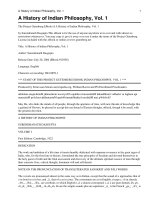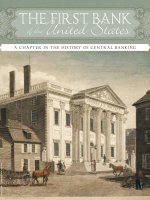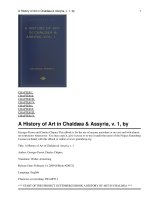Chapter 1 A HISTORY OF BRITAIN
Bạn đang xem bản rút gọn của tài liệu. Xem và tải ngay bản đầy đủ của tài liệu tại đây (1.27 MB, 31 trang )
Chapter 1
A HISTORY OF BRITAIN
Introduction to British Studies – ULIS – VNUH
Edited by Hong Nguyen
Outline
•
•
•
•
•
•
•
•
•
Prehistory
The Roman period (43 - 410)
The Germanic invasion (410 - 1066)
The medieval period (1066 - 1485)
The sixteenth century
The seventeenth century
The eighteenth century
The nineteenth century
The twentieth century
PREHISTORY
• Important physical remnant of the early
Britons: Stonehenge built some time between
3050 and 2300 BC.
o The construction took several phases to
complete.
o
Theories of its use: ceremony ground,
burial ground, astronomical clock,
sundial …etc
• Since 8th cent. B.C: Land of the Celts and the
Celtic culture.
THE ROMAN PERIOD
•AD 43: The Romans came to invade Britain,
and stayed.
•AD 410: The Romans left, leaving little
impact behind.
Notable event:
•AD 61: The revolt of Queen Boudicca against
the Romans.
The Roman period
A Celtic tribe (the Scots)
migrated from Ireland to
Scotland
The Hadrian’s Wall
Scotland: The Scots allied
with the Picts (also Celtic)
against the Romans
The Romans built the
Hadrian’s wall to protect from
attacks by the Scots and the
Picts
(most of) England & Wales:
The Roman province of Britannia
GERMANIC INVASIONS
•400s: Two tribes Angles and Saxons invaded Britain
and soon ruled the South-east.
With their arrival, Christianity spread throughout
Britain.
800s: Another wave of invasion raised by the Vikings ,
yet halted by King Alfred.
England was divided.
•900s: Cultural and religious similarities merged two
divisions into one united kingdom.
MEDIEVAL PERIOD I
•Norman invasion of England in 1066.
•England brought into the mainstream of western Europe.
•Formation of language and class division.
Notable event:
•1066: The Battle of Hastings – the last time Britain was
successfully invaded.
MEDIEVAL PERIOD II
•Late 1300s: Spread of the English monarch to
other part of the British Isles.
•1300s: English became the dominant language.
•Cultural split still existed in the British Isles.
Notable events:
• Magna Carta (1215)
• The Black Death (1348-1350 in Britain)
• The Wars of the Roses (1455-1485)
Notable figure:
•The legendary folk hero Robin Hood.
Medieval Period II
• A strict feudal system in England
King
The beginning of
the English class system
Great lords or Barons
French-speaking Normans
Lesser lords
Peasants
English-speaking Saxons
Medieval Period II
The Norman culture after 250 years did not gain predominance
Scotland: Remain independent
Eastern Ireland: controlled by AngloNorman lords in the name of the
English king
a gradual shift to English language
and customs (in the lowlands)
culture split
The lords remained loyal to the
English king
The (Celtic) Welsh language and
culture remained strong, e.g.
Eisteddfod
s
on
asi
inv
an ury
orm ent
e N 1th c
1
Th
Wales: under the English
king’s direct rule
England: A strict feudal
system brought by the
Norman since 11th century
• Germanic language, not the
Norman language (=French)
•The Anglo-Saxon concept of
common law, not Roman law
THE SIXTEEN CENTURY
•The increasing power of the English monarch.
•The reign of the Tudor dynasty (1485-1603)
•The rise of Protestantism – majority religion
in England.
Notable figures:
•Henry VIII
•Elizabeth I
Henry VIII (r.1509-1547)
& the rise of Protestantism
Elizabeth I
(r.1558-1603)
The 16th century
Rejection of
Roman Church
+
A new spirit of
patriotic
confidence
The country became an
“island nation”
+
The exploration of the Americas
and other parts of the world
Protestantism,
taking a form as
Anglicanism
became the major
religion in England
Britain was
closer to the
geographical
centre of the
western
civilization
(not on the
edge)
THE SEVENTEENTH CENTURY I
•The rise of the Stuart dynasty.
•Conflict between the parliament and the
Stuart monarchs about their way of raising
money.
•Puritanism and its classification of
immorality.
Notable event:
•The Civil Wars & the execution of Charles I
The Civil Wars (1642 - 1651)
Cavaliers
Victory
‘Roundheads’
Fun-loving, aristocratic
royalist
Over-serious, puritan
Parliamentarian
Oliver Cromwell
Results:
• Execution of Charles I, the 2nd son of James I (1649)
• the exile of his son Charles II
• Cromwell, leader of the Parliamentary army became ‘Lord
Protector’ of the republic with a military government
Britain became a republic for the 1st and only time
THE SEVENTEENTH CENTURY II
•
The shift of power among the monarchs, from Charles I
to Cromwell, James II to William of Orange.
•
Powers of the monarch was limited: the monarch could
rule only with the support of Parliament.
•
Origin of the split in society in modern Northern Ireland
THE EIGHTEENTH CENTURY
•A politically stable period.
•Establishment of annual budget system.
•Two divisions in Parliament
•Colonization & industrialization.
Notable events:
•The 1707 Act of Union
•Industrial Revolution
Territory Expansion
• This century was marked by cultural change
• Britain expanded its empire in
– The Americas
– West African coast
New markets
– India
First Industrial Revolution
• Causes: new markets + technological
innovations in manufacturing & transports…
• Industrial growth and urban development.
• The North being the industrial centre, the
reverse of today situation.
THE NINETEENTH CENTURY
•The biggest empire in the world after the end of the
century
•An enormous increase of wealth
•A change in attitude towards colonization (the white
man’s burden)
•Most people lived in towns or cities.
•Set of moral values built.
•Reform in political (more of a modern state) and
public life (human rights recognized in laws).
•A turn from industrial life-style to the country-side.
Notable figure:
•Queen Victoria
The expansion of the British Empire
• Biggest empire the world had ever seen (in early 20th cent.)
Ireland: British
culture and way of
life predominated
Canada, Australia and
New Zealand: selfgoverned but recognized
the overall authority of
British government
India: British officials
developed a distinctive
Anglo-Indian way of life,
imposing British institution
and methods of
government
Africa: most colonies started as
trading bases on the coast and
had little British settlement,
except for South Africa
The 19th century
• Changes in social structure
In the past
In the 19th century
Most people live in rural
areas
Most people lived in towns
and cities
Depended on landowners
for their living
Depended on factory
owners for their living
Together with the middle class of tradespeople
Victorian values
Held the REAL POWER in
the country
Victorian Era
• One of the most memorable and endearing
of the English monarchs
• Nostalgia and protests against new lifestyle
Queen Victoria (r.1837-1901)
THE TWENTIETH CENTURY I
•No longer the world’s richest country.
•A period of extremism during the first 20 years.
•Two major problems resolved:
- Women’s right to vote – the Suffragettes
- New types and levels of taxation
•Urban working class made their voice heard. (1)
•Trade unions able to self-organize.
•Divided community in Northern Ireland
•Notable events: World Wars
THE TWENTIETH CENTURY II
•End of the British Empire
•Part of the Commonwealth, NATO and EU
•A major growth in population & large-scale immigration
•Changing moral codes (people became more individualistic and
less differential)
•Labour Party and its Conservative rival alternating in power
•Notable figures:
-Queen Elizabeth II
-Margaret Thatcher









